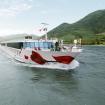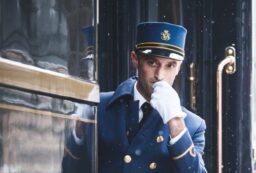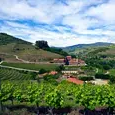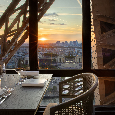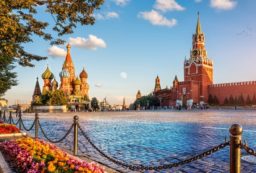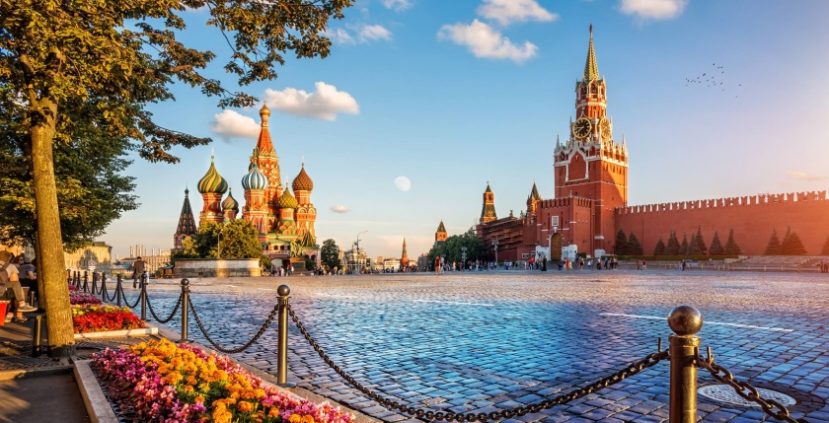
By Nick Walton
Riding east on the Trans-Siberian Railroad is an opportunity to trace Russia’s rich history, but the longest train journey in the world need not be without its creature comforts, discovers Nick Walton.
Like a well-tuned chorus, the railways band, resplendent in its crisp, military-style uniform, strikes up as the towering red locomotive of the Golden Eagle Trans-Siberian Express wheezes its way into Moscow’s Kazansky Railway Station. It’s nothing if not impressive, nine gleaming passenger carriages in azure blue, touched with gold lettering and pulled by both an electric locomotive and, if only for the first hundred miles, a historic steam engine, complete with a red Soviet star on its boilerplate.

Kazansky, one of nine railway terminals in the Russian capital, is a fitting departure point for such an epic journey. Dedicated to the rail lines that radiate east to Kazan, Yekaterinburg and Vladivostok, the station’s soaring curved roof, bustling concourses, steaming, chuffing trains, and marching band, which is now blasting out a revolutionary marching number, offer the perfect send-off on the world’s longest railway journey.
Opened in stages between 1891 and 1916, The Trans-Siberian is a steel ribbon that runs the length of the world’s largest country, an 11,000km lifeline that passes through eight time zones, numerous autonomous republics, and which connects major cities like Moscow and Novosibirsk with Siberia, the “Sleeping Land”, which reaches from the Ural Mountains to the Pacific and from the steeps of Kazakhstan and Mongolia to the Arctic Circle. But it’s more than just that – this ambitious rail route, the most expensive ever undertaken, is also a time machine, and travelling east, from the glamour of the capital to the crashing waves of the Pacific Ocean, it offers a chance to step back through Russia’s rich and often tumultuous history.

The band’s trumpets and trombones not only signal the arrival of the train but also of its guests, 69 on this run, who are guided by young stewards in freshly pressed blue uniforms, and a small brigade of waiters and waitresses laden with silver trays of champagne. It’s here, as I follow the excited throng, that I start to get a sense of the trip ahead; the walk to my Silver Class compartment in carriage nine takes several minutes, and nearby, at the end of the platform, the vintage locomotive seems ready to leap into action.

Eventually, it has its chance; ranks of power lines criss-crossing grim Moscow suburbs and red and white smokestacks towering above factories quickly give way to verdant countryside and I find myself glued to my cabin’s large picture window. While the traditional Trans-Siberian trains are iconic for rail buffs, they also come with more than their fair share of challenges and discomforts, from language barriers to gruelling scheduling and the chance of an MSG overdose from the catering. However, the Golden Eagle, a luxurious rendition operated since 1991 by a UK-company, offers fine-dining, daily excursions, insightful lectures and plenty of privacy for guests across all classes, all for GBP10,000 per person, twin share.
"Eventually, ranks of power lines criss-crossing grim Moscow suburbs and red and white smokestacks towering above factories quickly give way to verdant countryside and I find myself glued to my cabin’s large picture window."
My compartment has a small table, a bench seat in blue velvet that my carriage’s stewards, Angeleka and Denis, convert into a bed each night, an LCD screen that offers access to an extensive collection of documentaries, and a combination toilet and shower. There are little compartments for all my belongings and I quickly feel right at home.

Dinner that night, in one of two sumptuous dining rooms, complete with cut crystal glasses and tuxedoed waiters, is my first chance to sum up the companions with whom I will spend the next 12 days; there are two quartets of Australians, one perpetually gloomy and grumpy, the other jovial and upbeat; Dutch and German rail buffs; couples from the US working their way down their bucket lists; six travellers from India who rarely speak to other guests, the men habitually looking for cell phone signals; and clutches of shy Taiwanese and Spanish speaking guests who have their own guide and translator.

Nothing short of a tractor pull prepares you for sleeping on the Golden Eagle. While the bed is very comfortable, and the cabin cool and cosy, the train never stops its shuddering, samba-like sway as it races east. At times I’m sure I’ll be thrown out of bed and grip its wooden sides through the turbulence. Seemingly endless cargo and passenger trains race past, each a blur of colour and a roar of squealing wheels and howling horns. It’s both exhausting and exhilarating.

By morning we’re greeted by blue skies that reach towards the horizons, and the soft, motherly voice of our train manager, Tatayana, an Irkutsk-native, who briefs us on our first destination, Kazan. A ticket on the Golden Eagle includes almost daily excursions; in Moscow, we visited Red Square and delved inside the Kremlin before feasting on borsch and dumplings at the city’s iconic Café Pushkin, and at each stop there are options to choose from.

While we’re all eager to cross the Urals and enter Siberia proper, there’s no denying the beauty of Kazan, an ancient city that’s remained an economic and political powerhouse. Here, in the capital of the Republic of Tartarstan, there’s time to trace our way along the banks of the confluence of the Volga and Kazanka Rivers, explore the Unesco-listed Kazan Kremlin (the word simply means fortress in Russian and many cities have their own “Kremlin”), and lunch at an authentic Tartar restaurant. Like Moscow, Kazan is a fusion of past and present; a stone’s throw from the towering minarets of the Qolsharif Mosque, modern al fresco restaurants line the banks of the Kazanka, and luxury SUVs jostle for space among a sea of Soviet-era Ladas. The city’s contemporary affluence is undeniable and at odds with many people’s perceptions of Russia beyond Moscow.

We step further back in time in Yekaterinburg; founded by Peter the Great in 1723, this city, located on the cusp of the Ural Mountains, was once completely closed off to foreigners due to its many armament factories. Under a blazing mid-morning sun, we visit the stunning Church of the Blood, built on the site of the execution of Tsar Nicholas II by the Bolsheviks. Russia is having a Romanov renaissance and the church was built in 2003 in place of the original structure, which was destroyed in the 1970s by then local party boss Boris Yeltsin (which he would later atone for in his memoirs), to tap into a growing reverence for Russia’s royal leaders past. In Yekaterinburg, guests have the choice to visit the point where Asia and Europe meet; or tour the city on foot, but I choose to explore the Yekaterinburg Military Museum, an expansive collection of military hardware produced in the city, ranging from Hind attack helicopters and armoured trains from Stalin’s era to Mig fighter-bombers and fragments of Gary Power’s US spy plane.

Novosibirsk is our first true Siberian city and one that has proudly retained its Soviet roots. The third largest city in Russia, Novosibirsk, or “New Siberia”, is often compared to Chicago because of its dramatic growth. At its heart is the Opera House, one of the largest in the world, where we take a private behind-the-scenes tour, before heading to the city’s outskirts, where the outdoor Railway Museum allows travellers the chance to step back in time and explore the giant locomotives, regal carriages, hospital trains and military rolling stock that first plied the great Trans-Siberian in the late 1800s.

We continue east, the train following a strict schedule on what remains one of the busiest parts of the route. In Irkutsk, for centuries an important trading post between Russia and China, I have the chance to join a cooking class and prepare classic Russian dishes, including Schi soup, blinis and Siberian dumplings, before visiting a stunning mansion once owned by Maria Volkonsky that’s now a museum dedicated to the aristocrats who failed in their Decemberist uprising against the Tsar in 1825 and who were exiled to remote Siberia for their crimes. We spend the late afternoon sharing brilliant home cooking and an opportunity to learn the traditions of the Russian banya sauna with the Shugantsev family at their countryside dacha, a quaint little collective of cottages wreathed by breathtaking summer gardens.
At dawn the next day we’re greeted by the waters of Lake Baikal, the deepest on the planet, and home to 20 percent of the world’s fresh water. In a deserted bay, we’re joined by another vintage Soviet-era steam locomotive, which will pull us for a further five hours around the lake’s edge, offering captivating photo opportunities. I join a few brave souls in taking an early morning dip, the freezing water sending us howling and laughing for shore. That evening, after a day spent learning about Baikal and traversing it by ferry, we dine on its banks with a magnificent barbeque prepared by the train’s culinary team.

Our time travel continues in remote Ulan Ude, near the border with Mongolia, where we meet the Old Believers, a community of Orthodox Christians who fled the persecution of Russia’s 17th-century Tsars and found a home in the often-harsh heart of Siberia, where temperatures can drop to below -40C. We’re welcomed to the village, with its dusty roads and timber homes adorned with sky blue shutters to ward off evil spirits, by Zinaida, a wizened old woman who invites us into her simple cottage and dresses in the flowing colourful robes of the Old Believers. At a nearby community centre, village elder Galina tells us of the group’s faith and customs, and after a lunch of hand-rolled meatballs and cured fish, sings love songs and haunting dirges in her native tongue.

Our journey on the Gold Eagle is nearing an end. After a day spent across the border, in Mongolia’s manic capital city, where 15 passengers depart the train, we set off on three days of riding the rails non-stop to Vladivostok. In many ways this is my favourite part of our epic journey; without the daily itinerary, there’s a chance to sit back and soak up the wilds of Siberia, which I do from a tiny open-air platform mid-way down the train. We’ve left most of the passenger trains behind yet the line is still busy with freight trains roaring past regularly As we speed east, the sky turns heavy and silver and pine forests arrive like the first dusting of snow; before long they dominate the horizon. Between great forests and meadows ablaze in wildflowers are tiny hamlets, their timber houses the colour of molasses, with beehives and flowering potatoes in the yards. Each ramshackle village is a legacy described in broken concrete and abandoned factories with darkened windows. In places, it’s hard to tell where the wooden cottages end and the piles of winter firewood begin. Each settlement is seemingly under siege from the vastness of the landscape, each a swimmer clinging to the lifeline that is the Trans-Siberian. The signal fades from my phone as the light fades from the sky, and the air fills with pine and wood smoke as one cargo train after another passes, headed west.
We arrive in the port city of Vladivostok, our appetite for Russia’s vast wilderness sated, our understanding of this diverse and awe-inspiring landscape deepened. Will I miss the challenge of walking the train’s length while it shudders and jerks; the chance of being thrown from bed; the utter isolation from the world beyond? Perhaps not.
 But I know I’ll miss the Golden Eagle, with its smiling crew who have all become friends, and I already miss Siberia, seeing Russia old and young, and the sense of discovery that await Trans-Siberian travellers around every bend.
But I know I’ll miss the Golden Eagle, with its smiling crew who have all become friends, and I already miss Siberia, seeing Russia old and young, and the sense of discovery that await Trans-Siberian travellers around every bend.
